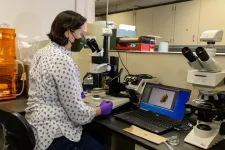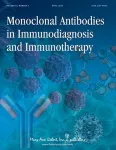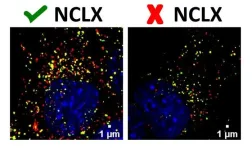(Press-News.org) HOUSTON – (May 2, 2024) – Rice University’s Ramamoorthy Ramesh and Frank Reese Harvey are among 120 new U.S. members elected to the National Academy of Sciences (NAS) “in recognition of their distinguished and continuing achievements in original research,” according to a statement from the organization.
Members are elected by their peers based on their contribution to one of six areas of scientific inquiry following an extensive vetting process. Established in 1863 through an act of Congress, NAS serves as a source of independent, objective advice on science and technology matters of national interest. Approximately 190 of the organization’s current 2,900 members (including 500 international members) have received Nobel prizes.
Ramesh is Rice’s executive vice president for research and professor of materials science and nanoengineering and physics and astronomy. Previously, he served as the Purnendu Chatterjee Chair in Energy Technologies at the University of California, Berkeley, director of the Berkeley Nanoscience and Nanoengineering Institute, founding director of the U.S. Department of Energy SunShot Initiative, deputy director of science and technology at Oak Ridge National Laboratory and associate laboratory director at the Lawrence Berkeley National Laboratory. Ramesh’s research explores the unique properties, synthesis and design of multiferroic materials with discoveries stemming from this work serving as a springboard for potential logic-in-memory applications. Ramesh earned B.A. degrees from Madras University and the Indian Institute of Science, Bangalore, and an M.A. and Ph.D. from UC Berkeley.
“I am deeply honored by this recognition and would like to express my gratitude to the mentors, colleagues, students and most importantly the funding agencies who have supported me in my journey,” Ramesh said. “I’ve always been driven by the unparalleled feeling of excitement that comes with uncovering new knowledge, and I see it as part of my mission to help foster that feeling and help drive discovery, not just in my own field but for research in the broadest sense, across disciplines.”
“I’ve always aspired to the distinction of being recognized as a member of the National Academy of Sciences, so I am humbled and honored this has come to pass,” said Harvey, professor emeritus of mathematics who was Rice’s Edgar Odell Lovett Professor when he retired. “I really enjoyed sharing my love of mathematics during my years of teaching at Rice, especially since the students are so brilliant, and it has been rewarding to have some of them share that passion and go on to enjoy careers in mathematics as well. Upon retirement from Rice in 2003, my passion for mathematics has only increased.”
Harvey’s research focuses on analysis and geometry ⎯ specifically complex variables, partial differential equations, differential geometry and most recently nonlinear elliptic equations. He is a co-author on the 1982 work which introduced calibrated geometry and is one of the most widely cited papers in the field. After his retirement, Harvey continued to dedicate himself to research, increasing his previous publication amount by over 68%. Harvey joined Rice’s faculty in 1968 and holds a B.S. and M.A. from Carnegie Mellon University and a Ph.D. from Stanford University.
President Reginald DesRoches said “the election of Ramesh Ramamoorthy and F. Reese Harvey to the U.S. National Academy of Sciences marks a milestone in Rice University’s legacy of excellence in research and academic distinction.”
“It is a testament to their profound contributions to their respective fields and underscores Rice’s commitment to fostering groundbreaking scholarship,” DesRoches said. “As we celebrate this achievement, we also reaffirm our dedication to advancing knowledge and shaping the future through innovative research and academic leadership.”
Ramesh and Harvey’s induction brings the total number of NAS members among living Rice faculty to 11 and 17 overall.
“Ramesh and Harvey are brilliant thinkers and widely cited scholars who have made an immense impact on their fields and beyond,” said Amy Dittmar, the Howard R. Hughes Provost and executive vice president for academic affairs. “It’s an honor to have not one but two Rice faculty selected for this highly prestigious membership, which recognizes their excellence.”
Thomas Killian, dean of the Wiess School of Natural Sciences and a professor of physics and astronomy, highlighted Ramesh as “a remarkable and inspiring leader of the scientific enterprise, whose pathbreaking research on the synthesis and properties of advanced materials has had great impact on energy and information technologies.” Killian also underscored that “Harvey’s work on the properties of manifolds, and how to describe them, laid the foundation for a new field of math called ‘calibrated geometries,’ which illuminates fundamental connections between mathematical functions and geometric shapes.”
“Ramesh and Harvey are among Rice’s most distinguished scholars, and I am delighted they have received this honor,” Killian said.
Luay Nakhleh, the William and Stephanie Sick Dean of the George R. Brown School of Engineering, offered his congratulations to Ramesh, who holds primary appointments in both the school of natural sciences and the school of engineering, saying the distinction bears witness to “his remarkable career in academia, national labs and beyond.”
“His tireless efforts in advancing materials science and engineering is shaping the landscape of renewable energy and microelectronics research and development worldwide,” Nakhleh said.
END
Rice’s Harvey, Ramesh named to National Academy of Sciences
2024-05-02
ELSE PRESS RELEASES FROM THIS DATE:
Oil palm plantations are driving massive downstream impact to watershed
2024-05-02
AMHERST, Mass. – The global demand for palm oil—the most widely consumed vegetable oil on the planet, in everything from instant noodles to lipstick—is driving worldwide tropical deforestation. While many studies have shown the loss of biodiversity when rainforests are converted to oil palm plantations, researchers at the University of Massachusetts of Amherst are the first to show far-reaching and wide-ranging disturbances to the watersheds in which such plantations occur. Because many Indigenous peoples rely on water downstream from the plantations for their daily needs, the marked decrease in water quality has ...
Nanotubes, nanoparticles, and antibodies detect tiny amounts of fentanyl
2024-05-02
A research team at Pitt led by Alexander Star, a chemistry professor in the Kenneth P. Dietrich School of Arts and Sciences, has developed a fentanyl sensor that is six orders of magnitude more sensitive than any electrochemical sensor for the drug reported in the past five years. The portable sensor can also tell the difference between fentanyl and other opioids.
Their work was published in the journal Small.
Fentanyl is a synthetic opioid and one of the main drivers in overdose deaths in the United States, Star said. It’s often mixed with other drugs, but because ...
New eco-friendly lubricant additives protect turbine equipment, waterways
2024-05-02
Scientists at the Department of Energy’s Oak Ridge National Laboratory have developed lubricant additives that protect both water turbine equipment and the surrounding environment.
Each year, roughly 2.47 billion gallons of lubricating oil are consumed in the United States alone for engines and industrial machinery, according to DOE, with about half eventually finding its way into the environment.
While environmentally acceptable lubricants are available, they are not optimized with additives that can greatly improve performance while posing minimal environmental impact if accidentally released. To create nontoxic, biodegradable and high-performing lubricant ...
Monoclonal Antibodies in Immunodiagnosis and Immunotherapy appoints new Deputy Editor-in-Chief, Andrei Moroz, PhD
2024-05-02
Mary Ann Liebert, Inc., is pleased that Andrei Moroz, PhD, has been appointed the new Deputy Editor-in-Chief of the bimonthly journal Monoclonal Antibodies in Immunodiagnosis and Immunotherapy. Dr. Moroz is joining Cory Brooks, PhD, as part of the senior editorial leadership team for the journal.
Monoclonal Antibodies in Immunodiagnosis and Immunotherapy is a peer-reviewed venue for promoting and sharing research rooted in hybridoma technology. It aims at advancing the understanding of the biology and immunology that underscores the utility of antibodies as diagnostics and therapeutics. The journal publishes ...
Optical pumped magnetometer magnetocardiography as a potential method of therapy monitoring in fulminant myocarditis
2024-05-02
https://www.scienceopen.com/hosted-document?doi=10.15212/CVIA.2024.0031
Announcing a new article publication for Cardiovascular Innovations and Applications journal. Fulminant myocarditis (FM) is associated with high mortality and an unfavorable long-term prognosis. However, noninvasive, rapid diagnostic and monitoring methods for FM are lacking.
This article details the case of a patient diagnosed with FM through a comprehensive assessment involving typical clinical symptoms, laboratory analyses, echocardiographic evidence, and cardiac magnetic resonance (CMR) findings. Before the patient underwent CMR, optical pumped magnetometer magnetocardiography (OPM-MCG) revealed abnormalities characteristic ...
Heart failure registries in Asia – what have we learned?
2024-05-02
https://www.scienceopen.com/hosted-document?doi=10.15212/CVIA.2024.0026
Announcing a new article publication for Cardiovascular Innovations and Applications journal. Heart Failure (HF) is one of the leading problems in cardiology practice today. Acute decompensated heart failure (ADHF) is a significant cause of mortality and morbidity worldwide, and this is more relevant in the Asian subcontinent with a high population burden. Various regional registries in Asia have given us valuable insight into the aetiology and outcomes in this context. Though there are regional differences, it is clear from the review carried out in this paper that HF affects a much younger population. ...
Study helps understand how energy metabolism is regulated at cellular level
2024-05-02
An article published in The Faseb Journal describes a Brazilian study analyzing the correlation between two key energy metabolism regulation processes: the absorption and release of calcium ions by mitochondria, the organelles that generate energy for cells; and autophagy induced by calorie restriction. Autophagy occurs when cells break down and reuse their own cytoplasm.
The study was conducted at the Center for Research on Redox Processes in Biomedicine (Redoxome), a Research, Innovation and Dissemination Center (RIDC) funded by FAPESP and hosted by the University of São Paulo’s Institute of Chemistry ...
Stay active – or get active – to boost quality of life while aging, study suggests to middle-aged women
2024-05-02
Consistent adherence to physical activity guidelines throughout middle-age is associated with a higher health-related quality of life in women, according to a new study publishing May 2nd in the open-access journal PLOS Medicine by Binh Nguyen of University of Sydney, Australia, and colleagues.
The evidence for an association between physical activity and health-related quality of life has been based primarily on cross-sectional studies and short-term randomized controlled trials. Few longitudinal studies have measured physical activity at more than one time point and examined the long-term causal effects ...
*FREE* Friendship-nomination approach identifies key villagers to diffuse health messages
2024-05-02
In experiments in isolated villages in Honduras, researchers evaluated a new strategy for identifying individuals that could be targeted for effective information spreading. Their approach – more effective than random targeting, and also less time-requisite than approaches that require a complete understanding of the relevant social network – could have far-reaching policy implications in lower and middle-income countries. Understanding the structure and function of human social networks has yielded insights for exploiting social ...
Chromosomal 22q11.2 deletion confers risk for severe spina bifida
2024-05-02
Chromosomal 22q11.2 deletions increase risk for meningomyelocele, one of the most severe and common forms of spina bifida, researchers report. According to the findings, this risk is mediated by the loss of Crkl, one of several neural tube expressed genes located on the 22q11.2 deletion interval, and this risk is only partially alleviated by folate supplementation. Meningomyelocele (MM) is a severe type of neural tube defect, which often requires pre- or post-natal surgical repair and can result in a variety of physical and developmental difficulties. Although the incidence of the condition has declined in recent decades, largely due to folic acid (FA) fortification, MM ...







